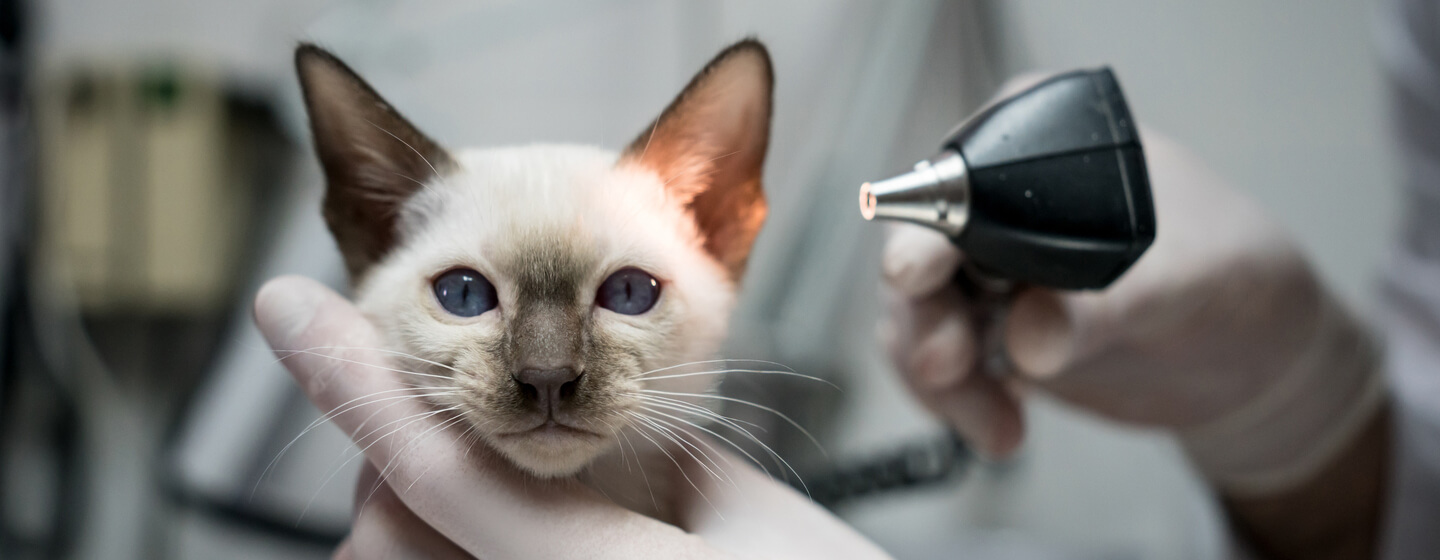To get rid of ear mites in cats, clean the ears with a vet-approved ear cleaner and apply a prescribed medication for ear mites treatment. Ear mites in cats can be effectively eliminated by following a two-step process involving cleaning and medication.
Cleaning the ears with a vet-approved ear cleaner helps remove any debris or mite eggs, while the prescribed medication specifically targets and kills the mites. Regular cleaning and treatment can help ensure the complete eradication of ear mites while also providing relief to your cat.
It is important to consult with a veterinarian to obtain a proper diagnosis and appropriate treatment options for your cat’s specific condition. Taking prompt action can help prevent further discomfort and potential complications caused by ear mites.
What Are Ear Mites?
Ear mites are tiny parasites that infest cats’ ears, causing discomfort and irritation. These mites have a lifecycle that involves four stages: egg, larva, nymph, and adult. They are highly contagious and easily spread from one cat to another through direct contact.
Ear mites can cause a range of symptoms, including intense itching, head shaking, ear scratching, and the presence of dark discharge in the ear. In severe cases, cats may develop secondary infections and experience hearing loss. Regularly inspecting your cat’s ears and looking out for these signs can help detect and treat ear mite infestations early.
If you suspect your cat has ear mites, it is important to seek veterinary advice for proper diagnosis and treatment.
How Do Cats Get Ear Mites?
Ear mites in cats can be transmitted through close contact with other infested animals. Cats that frequently roam outdoors or interact with stray cats are at a higher risk of contracting ear mites. These tiny parasites are commonly found in the ear canal and can cause discomfort and irritation for cats.
To prevent and treat ear mites, regular inspection of your cat’s ears is essential. Additionally, keeping your cat’s living environment clean and practicing good hygiene can help reduce the risk of infestation. If you suspect that your cat may have ear mites, it is important to consult with a veterinarian for a proper diagnosis and treatment plan.
With prompt attention and appropriate intervention, you can effectively get rid of ear mites in your feline companion.
How To Check For Ear Mites In Cats?
Ear mites are a common issue in cats that can cause discomfort and irritation. To check for ear mites, gently lift your cat’s ear and examine the inner surface. Look for signs such as dark discharge, redness, swelling, or a buildup of debris.
If you notice any of these physical signs, it is likely that your cat has ear mites. To confirm the diagnosis, you can also use a magnifying glass to look for tiny moving specks. If you suspect your cat has ear mites, it is important to consult with a veterinarian for proper treatment.
Home Remedies For Diagnosing Ear Mites
Ear mites in cats can be diagnosed using natural methods at home. DIY tests and at-home examinations can help confirm the presence of ear mites. By carefully observing your cat’s behavior and examining their ears, you may notice signs such as excessive scratching, head shaking, or dark, crusty debris in the ear canal.
To perform a simple DIY test, you can gently wipe the debris with a clean tissue and see if it leaves behind a reddish-brown residue, which could indicate ear mites. It’s important to note that home remedies can help alleviate the symptoms of ear mites, but it’s best to consult a veterinarian for proper diagnosis and treatment.
Ensuring your cat’s ears are clean and mite-free is essential for their overall health and well-being. So, don’t hesitate to take action if you suspect a problem.
Over-The-Counter Options For Ear Mite Treatment
Ear mites in cats can happen, but there are over-the-counter options for treatment. It’s important to know which ear mite products are recommended for cats. When using these medications, follow the instructions carefully to ensure effectiveness. Regularly clean your cat’s ears before applying the treatment.
Gently massage the medication into the ear, making sure to reach all affected areas. Pay attention to any signs of improvement or worsening after using the products. Remember to continue treatment for the recommended duration, even if symptoms disappear. Regularly inspect your cat’s ears for any signs of reinfection.
Consulting a veterinarian is advisable for severe or recurring cases of ear mites. With proper care and treatment, you can effectively get rid of ear mites in cats.
Prescription Medications For Ear Mites In Cats
Ear mites in cats can be treated with prescription medications recommended by veterinarians. These medications are specifically formulated to eliminate the mites and provide relief to your feline companion. It is important to follow the safety precautions and usage guidelines provided by the veterinarian.
These guidelines will ensure that the medication is administered correctly and that your cat does not experience any adverse effects. By following the instructions, you can effectively get rid of ear mites and improve your cat’s overall ear health. Veterinary prescribed treatments for ear mite infestations are designed to target the mites and prevent further infestations from occurring.
If you suspect that your cat has ear mites, it is best to consult with a veterinarian who can recommend the most appropriate prescription medication for your cat’s specific condition.
Home Remedies For Ear Mites In Cats
Ear mites in cats can be an annoying issue, but there are effective natural and holistic remedies to eliminate them. DIY treatments using common household ingredients can help relieve your cat’s discomfort. For instance, you can mix equal parts of warm water and apple cider vinegar to create a solution.
Using a dropper, put a few drops in your cat’s ear and massage it gently. This mixture will help kill the ear mites and soothe irritation. Another option is to mix a few drops of almond oil with vitamin E oil and apply it to your cat’s ears.
This will suffocate the mites and promote healing. Regularly cleaning your cat’s ears with a cotton ball dipped in warm water can also help prevent further infestations. By utilizing these natural approaches, you can effectively get rid of ear mites in your cat and provide them with relief from itching and discomfort.
Effective Preventive Measures For Ear Mites
Ear mites can be a nuisance for cats, but there are preventive measures you can take. Regular cleaning routines and proper hygiene practices create a healthy ear environment for cats. Clean your cat’s ears using a gentle, vet-approved ear cleaner.
Gently fold back the earflap and carefully clean the visible areas. Avoid using cotton swabs as they can damage the ears. Keep your cat’s living environment clean and free from dirt and dust. Regularly vacuum the house and wash their bedding.
If your cat spends time outdoors, regularly check their ears for any signs of mites. Early detection is crucial for effective treatment. Remember to consult with your veterinarian for guidance on the appropriate preventive measures for your cat’s specific needs.
By following these tips, you can keep ear mites at bay and ensure your cat’s ears stay healthy.
How To Keep Cats Protected Against Ear Mites
Cats can be protected against ear mites by following recommended preventive treatments. There are several options available, such as flea and tick treatments that also target ear mites. It is important to use these treatments regularly to keep the cats safe and free from infestation.
Additionally, it is crucial to practice good hygiene, cleaning the cat’s ears regularly and checking for any signs of mites. If a cat has been infested before, it is essential to take extra precautions to avoid re-infestation. This may include treating the cat’s environment and bedding, as well as using preventive treatments consistently.
By following these best practices, cat owners can effectively keep their furry friends protected against ear mites and prevent any future infestations.
When To Consult A Veterinarian For Ear Mites
Ear mites in cats can be a common issue, but there are times when it is necessary to consult a veterinarian. If you notice any red flags or severe symptoms in your cat, it is crucial to seek veterinary attention.
These symptoms may include excessive scratching, head shaking, ear discharge, or a foul odor. Professional diagnosis and treatment are important to ensure that the ear mites are properly eliminated. Veterinarians have the expertise to accurately diagnose the mites and prescribe appropriate medications or treatments.
They can also rule out any other underlying conditions that may be causing the symptoms. Remember, timely veterinary intervention can prevent the mites from causing further discomfort or complications for your cat.
Professional Treatment Options For Ear Mites
Ear mites in cats can be effectively eliminated through professional treatment options. Veterinarians utilize various procedures and techniques to tackle this issue. These include thorough cleaning of the ears, the use of prescription medications, and the application of special products designed to kill the mites.
Additionally, follow-up care and management play a crucial role in ongoing prevention. Regular ear checks, maintaining cleanliness, and using preventive measures recommended by the vet are essential. By closely following these professional treatment options and taking necessary preventive steps, cat owners can successfully get rid of ear mites and safeguard their feline companions from future infestations.

Credit: www.purina-arabia.com
Frequently Asked Questions Of How To Get Rid Of Ear Mites In Cats
How Can I Tell If My Cat Has Ear Mites?
If your cat is constantly scratching its ears, shaking its head, or has dark, crusty discharge in the ear canal, it may have ear mites. You may also see small white specks resembling coffee grounds in the ear. It’s essential to consult a veterinarian for a proper diagnosis and treatment.
Can Ear Mites Be Transmitted To Humans?
No, ear mites are species-specific and cannot be transmitted to humans. However, if your cat has ear mites, it’s crucial to handle them with caution and thoroughly wash your hands afterward to prevent any potential bacteria or parasites from spreading.
How Do I Treat Ear Mites In Cats?
Treatment for ear mites typically involves using prescription ear drops or medication prescribed by a veterinarian. It’s essential to follow the instructions carefully and complete the full course of treatment to ensure all mites and eggs are eliminated. Regular ear cleaning may also be recommended to prevent reinfestation.
Are There Any Home Remedies For Ear Mites In Cats?
While there are some home remedies suggested online, it’s not recommended to try them without consulting a veterinarian first. Home remedies may not be as effective or safe as prescribed medications. It’s best to seek professional advice to ensure the proper diagnosis and treatment of ear mites in cats.
Conclusion
To sum it up, getting rid of ear mites in cats is a common concern for many pet owners. The key is to act promptly upon noticing the symptoms, such as excessive scratching and a discharge from the ears. Start by cleaning the affected areas with a gentle cleanser recommended by your veterinarian.
Additionally, using a prescribed ear mite treatment solution, such as drops or creams, can effectively eliminate these pesky parasites. Maintaining good hygiene practices, such as regularly cleaning your cat’s ears and bedding, can also prevent re-infestation. Remember to consult with your vet for proper diagnosis and treatment options.
By following these steps, you’ll be able to provide your feline friend with the relief they deserve and ensure their overall well-being. Your furry companion will thank you for it!



